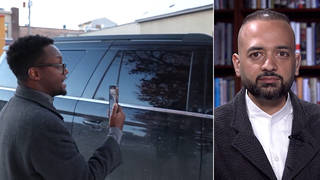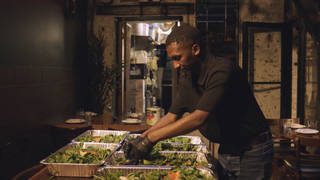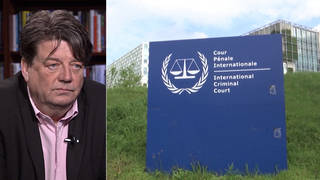
The victims were asleep the night of November 20, 2005, when marines burst into their homes and shot them dead. The military initially claimed 15 civilians had died in a roadside blast caused by insurgents. Human rights activists have described the killings in Haditha as perhaps the worst case of deliberate killing of Iraqi civilians by U.S. servicemembers since the war began. [includes rush transcript]
Transcript
JUAN GONZALEZ: Eight marines have been charged in connection with the killing of 24 Iraqis in the town of Haditha last year. The victims were asleep the night of November 20th, 2005, when marines burst into their homes and shot them dead. The military initially claimed 15 civilians had died in a roadside blast caused by insurgents. Human rights activists have described the killings in Haditha as perhaps the worst case of deliberate killing of Iraqi civilians by U.S. servicemembers since the war began.
Soon after the incident, the mayor of Haditha led an angry delegation up to a nearby Marine camp to seek redress. Their protests were ignored, and the U.S. military stood by its original contention, that the civilians were killed by a roadside bomb. The story would have ended there, had it not been taken up by Time magazine.
AMY GOODMAN: Time obtained a videotape shot in Haditha by an Iraqi journalism student one day after the attack. The tape shows that many of the victims, especially the women and children, were still in their nightclothes when they died. The scenes from inside the houses show the walls and ceilings are pockmarked with shrapnel, bullet holes and blood.
In January, Time presented a copy of the video, along with witness testimony, to U.S. military command in Baghdad. A preliminary military investigation was launched. It established the men, women and children were indeed killed by the marines, though it described the deaths as “collateral damage.”
Earlier this year, Aparisim Ghosh, the chief international correspondent for Time magazine, joined us on Democracy Now! to talk about Haditha.
APARISIM GHOSH: We looked into this case, and the more we dug, the more we thought that something didn’t quite add up. And when we finally got our hands on this videotape, it became very clear to us that these people could not have been killed outdoors by an explosive device. They were killed in their homes in their nightclothes. The nightclothes are significant, because Iraqi women and children, especially, are very, very unlikely to go outdoors wearing their nightclothes. It is a very conservative society.
When we first approached the Marines with this evidence, they responded in quite a hostile fashion. They accused us of buying into enemy propaganda. That aroused our suspicions even further, because it seemed to be excessively hostile on their part. And we dug even more. We spoke to witnesses. We spoke to survivors of this incident. And then we became quite convinced that these people were killed by the marines. What is left to be seen is whether they were killed in the course of the Marine operation as collateral damage or by accident, or whether the marines went on a rampage after one of their own had been killed and killed these people in revenge.
AMY GOODMAN: You are very graphic in the piece, “One Morning in Haditha.” Describe what the survivors say happened when the U.S. military went into the nearby houses around where the roadside bomb had exploded.
APARISIM GHOSH: Well, the survivors claim — let me back up a little bit. The marines claim that they received small-arms fire from nearby homes and that they responded to this fire, they shot back, and then they went into the homes to try and flush out the bad guys, the terrorists who were in there. It’s clear from the video that those homes don’t have any bullet marks outside, which would suggest that there was very little, if any, shooting by the marines at the facades of these homes. But there are lots of signs of bullets inside.
The victims told us that the marines came in and they killed everybody inside. In one house they threw a grenade into a kitchen. That set off a propane tank and nearly destroyed the kitchen and killed several people in that home. The scenes that were described by the survivors and the witnesses were incredibly bloody and very graphic. But they are, unfortunately, very commonplace in Iraq.
AMY GOODMAN: Inside, you talked to — you have the description of a nine-year-old girl.
APARISIM GHOSH: Yes.
AMY GOODMAN: Tell us about her and her family and what she says happened.
APARISIM GHOSH: Well, she was indoors with her family when the explosion took place. The explosion was loud enough to wake everybody up in the neighborhood.
AMY GOODMAN: The bomb that killed the marine.
APARISIM GHOSH: The first explosion, yes. And she says when she heard gunshots — of course, she’s a child, she was frightened. When the marines stormed towards their home, her grandfather slipped into the next room, as is, apparently, was his custom to pray, to reach out for the family Qur’an and pray to God that this crisis would pass. On this occasion, the marines came into the home. They entered the room where the grandfather was, and other members of the family, and killed him.
AMY GOODMAN: And she was left alive.
APARISIM GHOSH: She survived, yes.
AMY GOODMAN: And her little brother.
APARISIM GHOSH: And her brother was injured by a piece of — either by a bullet or a piece of shrapnel, we’re not sure.
AMY GOODMAN: But her parents, her mother, her father, her grandparents —
APARISIM GHOSH: Her parents, her grandparents, I believe her uncle, were also killed.
AMY GOODMAN: And then, another house.
APARISIM GHOSH: Four houses in all, involving a total of — indoors, total of 19 people, and four people outside.
AMY GOODMAN: Aparisim Ghosh, the chief international correspondent for Time magazine. He joined us in our studio last March.












Media Options